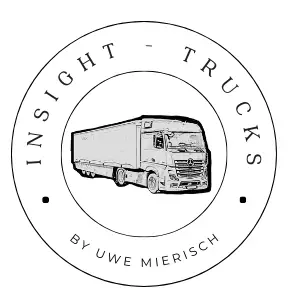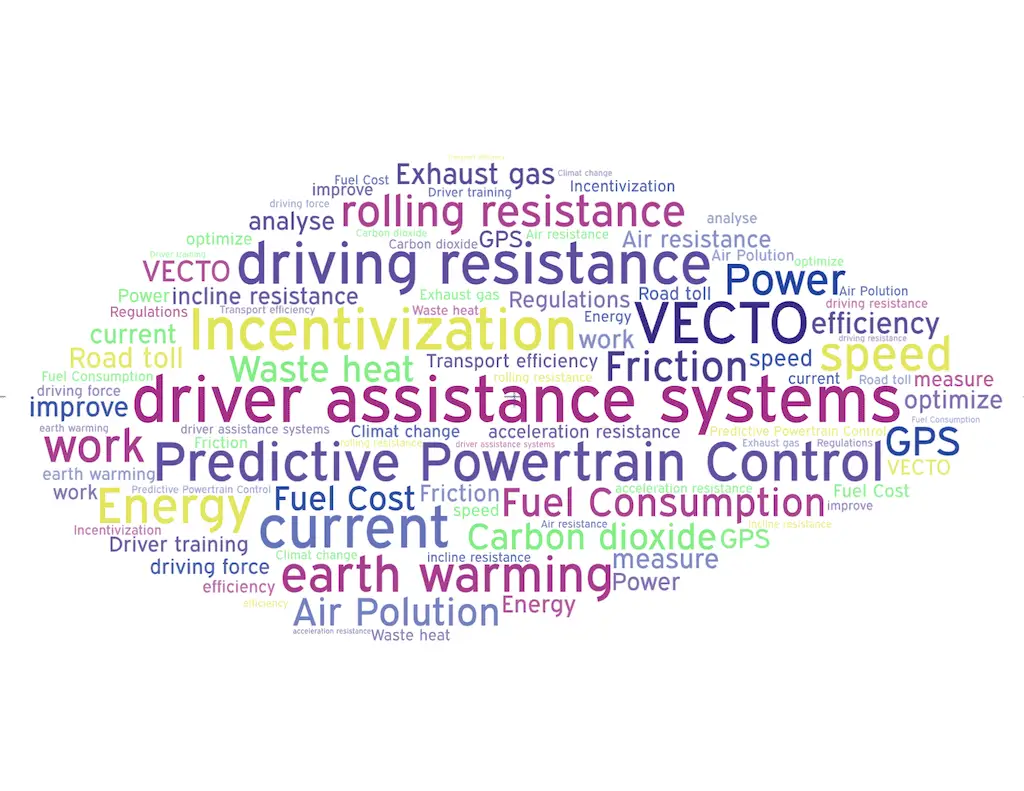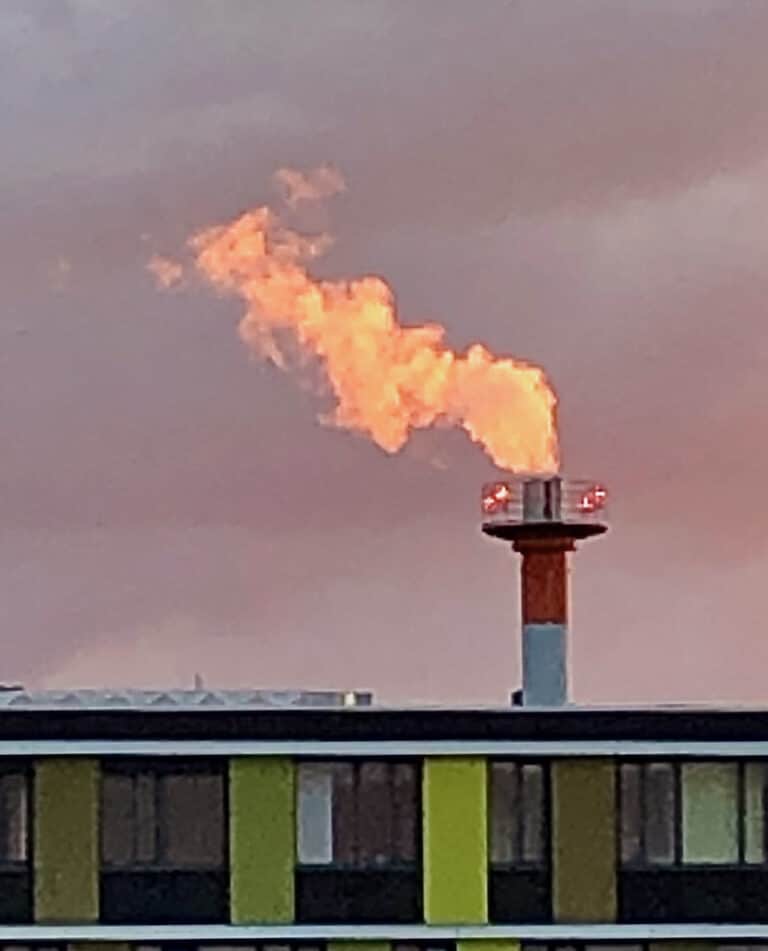Fuel Consumption Of Heavy Trucks – A Comprehensive Overview
My blog is all about the fuel and energy consumption of trucks
You will learn things that will help you in your job.
If you are not in this industry, perhaps it is still interesting and worth knowing.
Much of what you will read in my blog can also be transferred to cars.
I’ll explain what’s worth knowing. It should be provided in an entertaining and easy-to-understand way so that you can enjoy reading.
In this article, I will give you a comprehensive overview of the entire topic.
It serves as a guide through the material and will help you to choose your focal points and to guide you to further information in other articles.
If you want to jump directly to a topic, click on a link in the table of contents:
Is it still worth learning diesel consumption optimization?
Does it still make sense to optimize fuel consumption when electrically powered vehicles are the future?
In any case, it makes sense! In both cases, we are talking about energy consumption.
Today, I ask: “Why is my truck so thirsty?”
Tomorrow, I will ask: “Why does my truck draw so much electricity?”
The answers aren’t as different as the questions suggest.
I am going to look into both.
You will see that many subject areas apply equally to both types of drive. But of course, I will also write in detail about the differences.
General information on the subject of fuel consumption.
The subject of fuel consumption should always be looked at in the context of environmentalism, society, and politics.
In the category, You want to know that, you will find information about those related topics.
In the recent past, this topic has moved more and more into the center of public discussion.
I’ve been working on the problem for many years, much longer than Greta Thunberg was talking about. This is not new to me!
The internal combustion engine as a method of propulsion
At the beginning of its development, the internal combustion engine was seen as a great step forward. It enriched people’s lives.
It enabled personal mobility for large parts of the population and stimulated business and trade through efficient, professional transport.
This has now become indispensable normality and is no longer talked about.
I find it important to understand these concerns, so I will write about them.
One example is the relationship between carbon dioxide emissions and fuel consumption, which you will learn about in the article: 15 Answers About CO2 incl. Why It Comes Out Of The Truck Exhaust.
It is also exciting what the regulators come up with to increase motivation to reduce energy consumption.
So that too has to be a topic on my blog.
The electric motor as a method of propulsion
The replacement of the internal combustion engine with electric drives should solve the problem. Is that the ultimate solution?
In any case, many interesting aspects have to be explained and understood if the transport is to be CO2-neutral, sustainable, and environmentally friendly.
This topic will occupy me intensively in the next few years, and I will let you participate in it.
With this type of drive, too, we will be concerned with optimizing consumption.
The aspect of profitability in transport
Profitability improvement has always been a driver for working on measures to reduce consumption. The fuel consumption of trucks has therefore been falling continuously for many, many years. (You can read more about this in this article at Eurotransport.de.)
In the next few years, the focus will be more and more on economic efficiency as a means of political pressure to implement expensive measures to reduce consumption.
I am thinking of road tolls and CO2 taxes.
– Also an exciting topic. –
I will look into the practical suitability of the trucks during operation and into governmental incentives for alternative drive vehicles. This will keep me busy for the next few years.
Incentivization is the opposite of just-described punishment, using higher costs. The state gives money to promote desired technologies.
The improvement in practicality ultimately also means an improvement in profitability for the entrepreneur.
These are all exciting topics. I’m curious to see how the general topic category will develop over the next few years.
The physical basics
The category, You want to know that, will also contain information about the physical basics of the matter.
Most of it you have already learned in school.
These basics are very important for understanding.
So we are going to wipe the dust on the memories. I promise it will not be complicated. I am writing these articles in a very simple and practical way.
How often do we talk about power, work, and energy?
Do you remember what these terms really mean?
Sure, it’s logical that fuel consumption is somehow related to power, work, and energy, but how exactly?
It’s kind of weird.
We refer to electrical energy as electrical energy. For chemical energy, we say diesel or gasoline.
Both are forms of energy that we consume.
This is another misconception.
We don’t consume it. We convert it into kinetic energy so that the load can be moved forward.
Does that make you curious? Good!
How do the systems work in the vehicle and on what physical basis?
I find it very exciting and entertaining to establish the connection between physics and technology.
Somehow, it’s just fun when you can say to yourself: “Now I understand how it all relates!”
But what is even more important:
The result is lower costs, less environmental pollution, and better driving performance.
Measure the fuel consumption
The category Determining consumption is about determining the correct fuel consumption.
Believe me, it is not that easy to find out, how large the fuel consumption of your vehicle/vehicle fleet really is. Lots of mistakes happen.
But this information is incredibly important!
Every professional optimization starts with a baseline.
Measures are then derived from this, implemented and their effectiveness measured.
What I have summarized here briefly is the PDCA cycle. It has been discovered by Shewhart and Deming in the 1930th. It is a method for continuous improvement.
- P stands for “plan” – Analyzing the current situation and recognizing the potential for improvement.
- D stands for “Do” – Quickly trying out the measure.
- C stands for “Check” – Measuring and validating the improvement.
- A stands for “Act” – Rolling out the measures across the board and adapting the business to the new level of knowledge.
Alternatively, you can just change something and hope for the best. Sometimes it might also surprise you with a positive effect.
I prefer a more systematic approach.
With me, you will learn to optimize methodically and sustainably.
For this, it is indispensable:
- To use the right measurement method
- To measure correctly
- To recognize measurement errors
- To evaluate and minimize the effect of measurement errors on the conclusion.
And that is exactly what I will describe in great detail in this category.
You can find out which measurement methods are available in the article: “4 Ways To Determine The Correct Fuel Consumption”
In “4 Ways To Calculate Fuel Consumption (incl. calculator)” you can read how the different fuel consumption values are calculated. You will also find online calculators with which you can perform the calculation live.
“Why does fuel consumption vary? (a simple explanation)” addresses why fuel consumption values always vary. Variability is an annoying, disturbing factor in our fuel consumption measurements. You will learn which factors influence consumption values.
You can read everything about fleet monitoring under the menu item of the same name. There you will find the following articles:
In some of these articles, you have the opportunity to order a small calculation tool from me (free of charge), with which you can easily carry out fleet monitoring.
There is a method for successful improvement!
A colleague once said to me:
“Because I don’t know when I will have an idea, I don’t commit to any deadlines,”
I am not satisfied with this attitude.
I will explain it in detail using concrete examples.
One of the ways to improve consumption is to learn a fuel-saving, anticipatory driving style.
I would like to reveal at this point that this requires more than just measuring fuel consumption. Other fuel consumption influencing factors must also be recorded and evaluated.
All in all, this is a very exciting subject area, and there is a lot to do here. I’m already looking forward to it!
The driving resistances
The “driving resistances” suck the energy out of the vehicle— but sometimes they also give energy back —
The word “resistance” already says it all. Resistance somehow means that it will be hard to move. Usually, resistance is something that opposes movement.
However, transport is movement and therefore every driving resistance is bad in the first place!
To overcome the resistance and move forward, you must invest energy,
The relation between resistance, work, and energy will be explained in the “You want to know that” chapter. (From a physical point of view, resistance is a force.)
In the “Optimize consumption“ chapter, the aim is to understand the respective driving resistances and to optimize them in a targeted manner.
I deliberately don’t write “reduce”, but “optimize”. Some resistances can turn around, then suddenly they are no longer bad, but advantageous.
The driver assistance systems
I’m not telling you a secret when I say:
The driver has a great influence on fuel consumption.
So you have to deal with your drivers if you want to reduce fuel consumption.
If you are a driver yourself, then you will want to optimize your driving style.
There are two ways to do this.
Controlling the driver’s fuel consumption is not to be understood negatively!
Even as a driver, you want to know how good your driving style is and how to improve it in a targeted manner. The method of continuous improvement applies here as well.
Driver assistance systems must also be understood, used correctly, and continuously improved.
In today’s world, technology already has capabilities that go beyond human capabilities. We’re looking at that closely.
I will write in detail about how driver assistance systems work, and what limits and limitations they have. But also where they are superior to a human driver.
Predictive cruise control will take center stage. We will look at how such predictive cruise control works and why and when the EcoRoll and Pulse and Glide functions save fuel. I will also explain what conditions must be met for EcoRoll to shut down the engine, and what influencing factors affect EcoRoll’s fuel-saving potential.
You will be able to read about this in the category of driver assistance systems.
It is very, very important to understand driver assistance systems exactly.
As an entrepreneur, you have to be able to judge which truck with its assistance system promises a consumption advantage. To do this, you must be able to understand, control and plausibility check the information provided by the manufacturer.
I will give you the tools to do this, but I leave the formation of your own opinion up to you.
The drive train efficiency
Of course, we also need to look at the drive train and its losses
A drive train is an energy conversion device that always generates some heat as a waste product.
However, this waste heat is relatively useless. All energy and therefore fuel costs that end in waste heat are a waste of money. (Well, maybe apart from the heating in winter.)
Efficiency is defined as the ratio between the energy invested and the drive work that can be used.
So input versus output.
In the case of the internal combustion engine, it is an absolute disaster. More than half of the energy that is put into it ends up as waste heat.
If the engineers had not optimized the efficiency of the combustion powertrains, it would be even worse.
There is no doubt. The efficiency has to be improved continuously, although it is becoming more and more difficult.
In several articles, I will go into detail on this matter.
How is it with the electric drive?
The efficiency of electric drives can be significantly better than that of combustion engines. depending on which technology is used. (Battery vs. Fuel Cell) In addition, there is the possibility of energy recovery.
Even if the motivation is different, the subject of “drive train efficiency” will be of great interest also at electric drives.
The auxiliaries consume energy.
In addition to driving the vehicle, energy is also required for the operation of systems that are needed while driving.
I am talking about the steering system, the brakes, the suspension, and, for example, the lights.
Then there are the systems that are needed to operate the power unit itself. For example, the cooling system, the fuel system, etc.
This energy is also drawn from the energy storage system while driving.
Logically, this means that it is also necessary to optimize the energy consumption of these systems.
Outlook
As you can see, this is a huge topic. It will take me a long time to write down everything I know and am still learning.
In the end, you will be an expert in the field!
Over time, I will get past the functionality of many of the truck’s technical systems. I suspect that in the end, there won’t be a lot of the truck left that I won’t have written about.
If you are urgently interested in something that you cannot find here, just let me know, and I will integrate it or answer you directly.
Since I write the block in my spare time, you have to be patient with me. It will take me some time to write all of the important articles.
You are welcome to leave me your e-mail in the contact form, with the request to inform you when there is a new article.
The advantage of the blog format is that I can write article by article about the different content step by step, and you can also read article by article and don’t have to memorize everything at once.
I hope you enjoy reading it and I hope you find it interesting.
Feel free to give me comments I can read, questions that I can answer, or tips on how I can improve.




